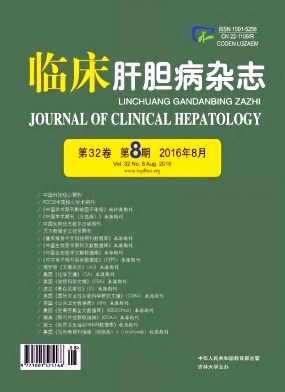|
[1] GINS P,CRDENAS A,ARROYO V,et al.Management of cirrhosis and ascites[J].N Engl J Med,2004,350(16):1646-1654.
|
|
[2] GINS P,ANGELI P,LENZ K,et al.EASL clinical practice guidelines on the management of ascites,spontaneous bacterial peritonitis,and hepatorenal syndrome in cirrhosis[J].J Hepatol,2010,53(3):397-417.
|
|
[3] RUNYON BA.Management of adult patients with ascites due to cirrhosis:update 2012[J].Hepatology,2013:1-25.
|
|
[4]SANYAL AJ,GENNING C,REDDY KR,et al.The North American study for the treatment of refractory ascite[J].Gastroenterology,2003,124(3):634-641.
|
|
[5]LEBREC D,GIUILY N,HADENGUE A,et al.Transjugular intrahepatic portosystemic shunt:comparison with paracentesis in patients with cirrhosis and refractory ascites:a randomized trial[J].J Hepatol,1996,25(12):135-144.
|
|
[6] RSSLE M,OCHS A,GULBERG V,et al.A comparison of paracentesis and transjugular intrahepatic portosystemic shunting in patients with ascites[J].N Engl J Med,2000,342(6):1701-1707.
|
|
[7]GINS P,URIZ J,CALAHORRA B,et al.Transjugular intrahepatic portosystemic shunting versus paracentesis plus albumin for refractory ascites in cirrhosis[J].Gastroenterology,2002,123(6):1839-1847.
|
|
[8] SALERNO F,MERLI M,RIGGIO O,et al.Randomized controlled study of TIPS versus paracentesis plus albumin in cirrhosis with severe ascites[J].Hepatology,2004,40(8):629-635.
|
|
[9] OCHS A,ROSSLE M,HAAG K,et al.The transjugular intrahepatic portosystemic stent-shunt procedure for refractory ascites[J].N Engl J Med,1995,332(5):1192-1197.
|
|
[10] SAAB S,NIETO JM,LEWIS SK,et al.TIPS versus paracentesis for cirrhotic patients with refractory ascites[J].Cochrane Database Syst Rev,2006,4(4):CD004889.
|
|
[11]WONG F,SNIDERMAN K,LIU P,et al.The mechanism of the initial natriuresis after transjugular intrahepatic portosystemic shunt[J].Gastroenterology,1997,112(3):899-907.
|
|
[12]TAN HK,JAMES PD,WONG F,et al.Long-term clinical outcome of patients with cirrhosis and refractory ascites treated with transjugular intrahepatic portosystemic shunt insertion[J].J Gastroenterol Hepatol,2015,30(2):389-395.
|
|
[13] CHUTAPUTTI A.Management of refractory ascites and hepatorenal syndrome[J].J Gastroenterol Hepatol,2002,17(4):456-461.
|
|
[14]SENZOLO M,CHOLONGITAS E,TIBBALL J,et al.Transjugular intrahepatic portosystemic shunt in the management of ascites and hepatorenal syndrome[J].Eur J Gastroenterol Hepatol,2006,18(11):1143-1150.
|
|
[15]BOYER TD.Transjugular intrahepatic portosystemic shunt:current status[J].Gastroenterology,2003,124(5):1700-1710.
|
|
[16]ALBILLOS A,BANARES R,GONZALEZ M,et al.A meta-analysis of transjugular intrahepatic portosystemic shunt versus paracentesis for refractory ascites[J].J Hepatol,2005,43(6):990-996.
|
|
[17]SALERNO F,CAMMA C,ENEA M,et al.Transjugular intrahepatic portosystemic shunt for refractory ascites:a meta-analysis of individual patient data[J].Gastroenterology,2007,133(3):825-834.
|
|
[18] NARAHARA Y,KANAZAWA H,FUKUDA T,et al.Transjugular intrahepatic portosystemic shunt versus paracentesis plus albumin in patients with refractory ascites who have good hepatic and renal function:a prospective randomized trial[J].J Gastroenterol,2011,46(1):78-85.
|
|
[19]BAI M,QI XS,YANG ZP,et al.TIPS improves liver transplantation-free survival in cirrhotic patients with refractory ascites:an updated meta-analysis[J].World J Gastroenterol,2014,20(10):2704-2714.
|
|
[20]FORREST EH,STANLEY AJ,REDHEAD DN,et al.Clinical response after transjugular intrahepatic portosystemic stent shunt insertion for refractory ascites in cirrhosis[J].Aliment Pharmacol Ther,1996,10(5):801-806.
|
|
[21]DESCHNES M,DUFRESNE MP,BUI B,et al.Predictors of clinical response to transjugular intrahepatic portosystemic shunt(TIPS)in cirrhotic patients with refractory ascites[J].Am J Gastroenterol,1999,94(5):1361-1365.
|
|
[22]BUREAU C,MTIVIER S,D'AMICO M,et al.Serum bilirubin and platelet count:a simple predictive model for survival in patients with refractory ascites treated by TIPS[J].J Hepatol,2011,54(5):901-907.
|
|
[23]HA MEL B,GUILLAUDA O,ROMAN S,et al.Prognostic factors in patients with refractory ascites treated by transjugular intrahepatic porto-systemic shunt:from the liver to the kidney[J].Dig Liver Dis,2014,46(8):1001-1007.
|
|
[24] PARVINIAN A,BUI JT,KNUTTINEN MG,et al.Transjugular intrahepatic portosystemic shunt for the treatment of medically refractory ascites[J].Diagn Interv Radiol,2014,20(1):58-64.
|
|
[25]TAKI Y,KANAZAWA H,NARAHARA Y,et al.Predictive factors for improvement of ascites after transjugular intrahepatic portosystemic shunt in patients with refractory ascites[J].Hepatol Res,2014,44(8):871-877.
|
|
[26]SERSTT,GUSTOT T,RAUTOU PE,et al.Severe hyponatremia is a better predictor of mortality than MELDNa in patients with cirrhosis and refractory ascites[J].J Hepatol,2012,57(2):274-280.
|
|
[27]HARROD-KIM P,SAAD WE,WALDMAN D,et al.Predictors of early mortality after transjugular intrahepatic portosystemic shunt creation for the treatment of refractory ascites[J].J Vasc Interv Radiol,2006,17(10):1605-1610.
|
|
[28]SANYAL AJ.Pros and cons of TIPS for refractory ascites[J].J Hepatol,2005,43(6):924-925.
|
|
[29]WU X,DING W,CAO J,et al.Clinical outcome using the fluency stent graft for transjugular intrahepatic portosystemic shunt in patients with portal hypertension[J].Am Surg,2013,79(3):305-312.
|









 本站查看
本站查看




 DownLoad:
DownLoad: